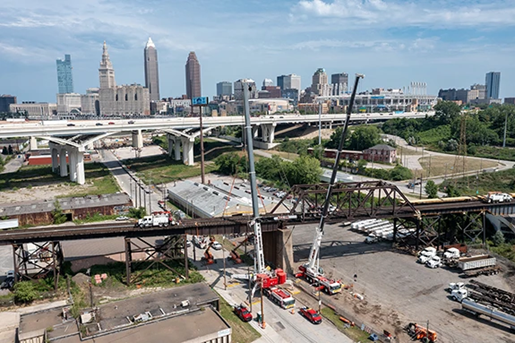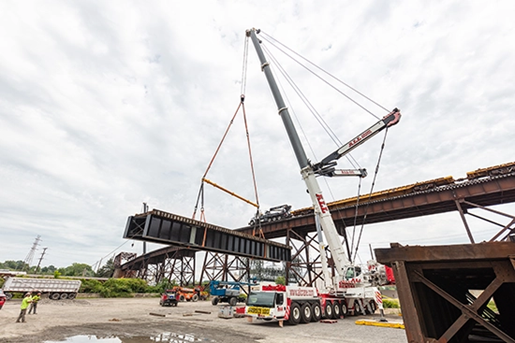
The challenge: replace a section of railroad bridge in a close, urban setting – in which you will need to use the remaining tracks to both roll the old bridge section away and roll the replacement section into the work zone.
The solution: a rarely seen heavy lift operation requiring two 900-ton cranes. Plus, they’ll be working side-by-side, but won’t be performing any dual picks.
“This kind of job only happens once or twice a career,” said Chad Rados, project coordinator for ALL Erection & Crane Rental, flagship branch of the ALL Family of Companies, which provided cranes for the job.
The operation happened this summer in Cleveland, Ohio, at the Norfolk Southern railroad bridge over West Third Street near the city’s downtown. One crane was set up directly on the street below the span, the other in a neighboring empty lot, with the cranes only approximately 25 feet apart.
“When you’re in the thick of planning the project, you’re thinking about all the little details that lead to a successful lift,” said Zac Kasparek, sales representative with ALL Erection & Crane Rental. “
Then the day came that we’ve got two 900-ton cranes set up and ready to work, and it occurred to me… the fact that we have two cranes of that size mobilized in one area, on the same job, is pretty impressive.”
Both were Liebherr LTM 1750-9.1 all terrain cranes configured with 161 feet of main boom and maximum counterweight. The crane on West Third Street, with its boom directly over the replacement area, was also outfitted with Y-guying to bolster boom capacity.
The operation called for the West Third Street crane to single-pick the old bridge section and set it on a flatbed rail car directly east of the now missing section, on a second set of tracks. A road-rail vehicle (a truck able to drive on train tracks) powered the flatbed to the east, where the second Liebherr LTM 1750 lifted the old section off the flatbed, lowered it to the lot below, then picked up the new replacement bridge section and set it on the flatbed.
The road-rail vehicle next drove the flatbed back to the Third Street crane, which picked it from the railcar and set it into the gap created by the absence of the old bridge section.
In essence, with the flatbed acting as a go-between, the two giant cranes formed an assembly line.
Total elapsed time: about seven hours.
The need to use two 900-ton cranes in this manner was prompted by a variety of factors. The top elevation of the bridge was 55 feet. Because of size of the bridge section, which measured 90 feet and weighed 243,000 pounds, rigging required a large spreader beam. The narrowness of West Third Street left no room to lay down the old bridge section or the new one, requiring a shift to the adjacent empty lot.
“This is a classic case of the job picking the cranes,” said Rados. “The site logistics told us it was going to have to be two cranes. The limited amount of room and weights of the two pieces made it clear that the two 1750s were the best option.”
It’s unusual to deploy two cranes with such high capacities on a single job. ALL owns three of the units, and pulled these two from branches in Lima, Ohio, and Atlanta.
It took approximately 40 truckloads to deliver both cranes to the deceptively complex job site, and two to three days total to assemble them before and disassemble them afterward. Meanwhile, crane maneuvers all took place within a single seven-hour period in which rail service to the tracks was shut down.
